Every successful SEO campaign starts with keyword research. Understanding it fully and weaving it into your strategy is non-negotiable. However, without the right tools, you’re flying blind.
You need a powerful keyword generator to get actual data and insights that will inform your SEO strategy. Otherwise, everything you do is just guesswork.
There are literally hundreds of keyword research tools available. How do you identify the absolute best?
It all boils down to the quality and volume of keyword ideas, overall user-friendliness, pricing, and value-added features.
This article will talk about Keywords Everywhere and how it checks all those boxes and changes how you experience keyword research as an SEO.
Why Use Keywords Everywhere?
Keywords Everywhere is all about accuracy, speed, and ease. We believe that you don’t have to go through hoops just to generate keyword ideas. Because it works as a browser extension, keyword research becomes 3x easier and 5x more effective—no logging in, no switching dashboards, no wasted time. Here’s what makes Keywords Everywhere a total game-changer for your SEO workflow:
1. Keyword data right on the search bar
You no longer have to log in to your keyword research tool just to confirm the search volume and other keyword data of a search term. You can readily obtain keyword information as you search and browse.

This functionality is not only applicable to Google. Keywords Everywhere supports 19+ other huge platforms like YouTube, Amazon, Etsy, eBay, and more. Whether you’re into YouTube SEO, eCommerce SEO, or general content marketing, you have an all-in-one tool that’s super easy to use.
2. Keyword details on Autosuggest
Savvy SEOs know that the autosuggest or autocomplete section is a gold mine of rich and long-tail keywords that reveal what users are actively searching for. Using Keywords Everywhere, it’s now easier than ever to pick low-hanging fruits and snag ideas from this keyword treasure trove. This feature is available across all platforms Keywords Everywhere supports.
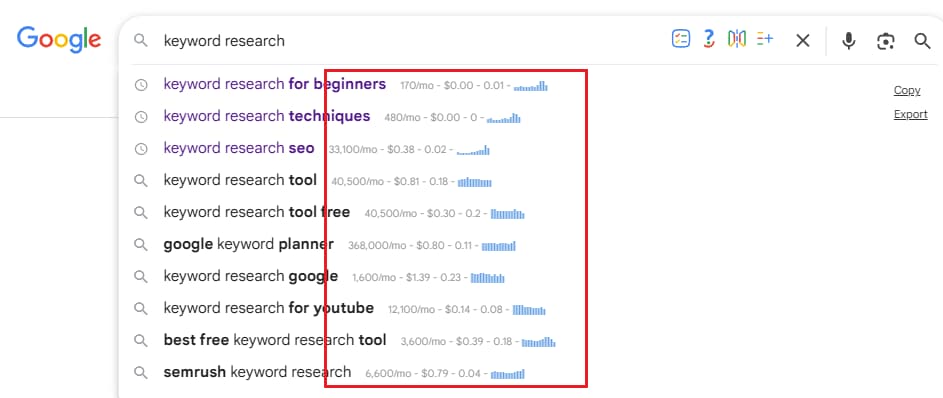
3. Powerful Keyword Grouping Features
When targeting keywords, you shouldn’t only focus on one search term. You can choose a primary keyword but should also use secondary or related keywords to further improve SEO rankings and content relevance. Keywords Everywhere makes it super easy to choose secondary keywords as everything is grouped neatly in different widgets.
Let’s discuss each widget one by one:
Related Keywords
Whenever you visit any supported platform, including Google, you can see all the widgets on the right side of the screen and more as you scroll down the page. The Related Keywords widget shows secondary or semantic keywords that you can use to further help search engines understand the context of your page. Using these related search terms not only helps with SEO but also GEO or Generative Engine Optimization, boosting visibility in AI-driven search.
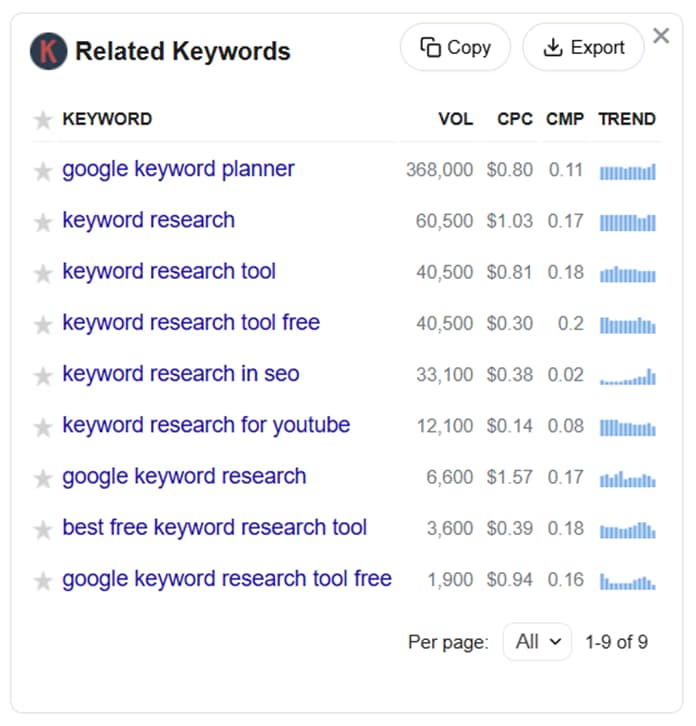
Long-Tail Keywords
Long-tail keywords are the longer and more specific search terms that may have lower search volume than head terms but can be easier to rank for and drive more targeted traffic. If your website is still new or you want to establish topical authority, making the most of long-tail keywords is a savvy SEO strategy.
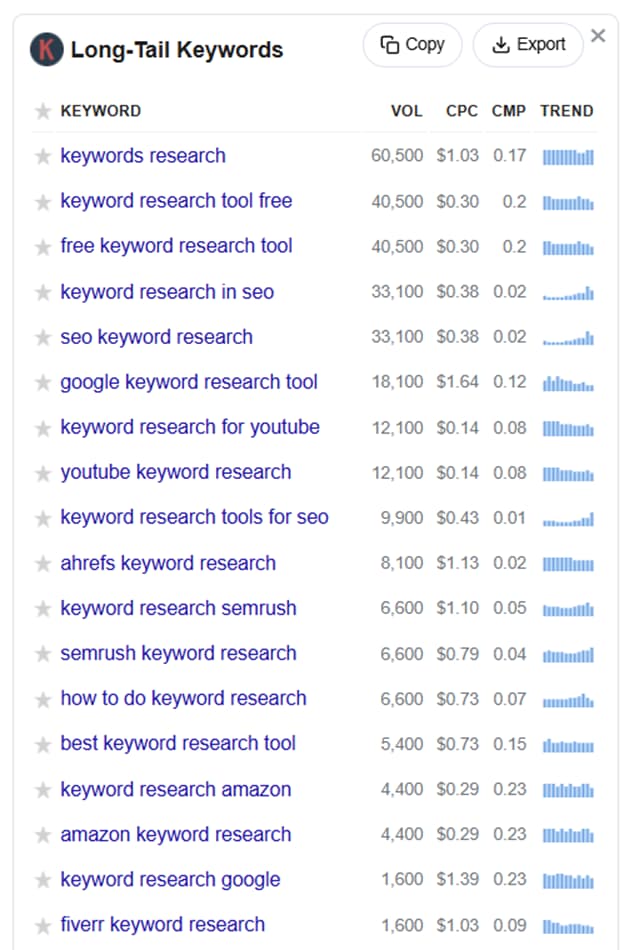
Trending Keywords
This widget can help you target search terms that have started to become more popular. Trending keywords likely haven’t been that oversaturated yet, which helps you have that head start to capture more traffic before the competitors catch on.
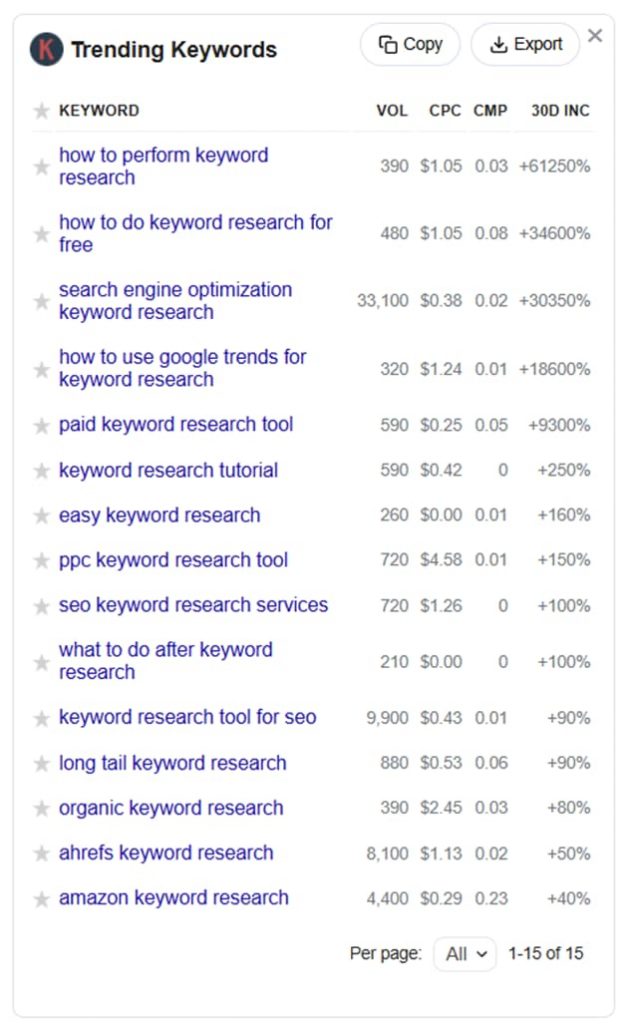
SERP and People Also Search For Keywords
These widgets are another goldmine for secondary keywords and also reveal user intent overlaps, which can help you expand your topic coverage. Google rewards content that’s better, more helpful, and more comprehensive than the rest of the competing pages. Incorporating related ideas into your content can help show topic breadth and depth, making it irresistible in the eyes of the crawlers.
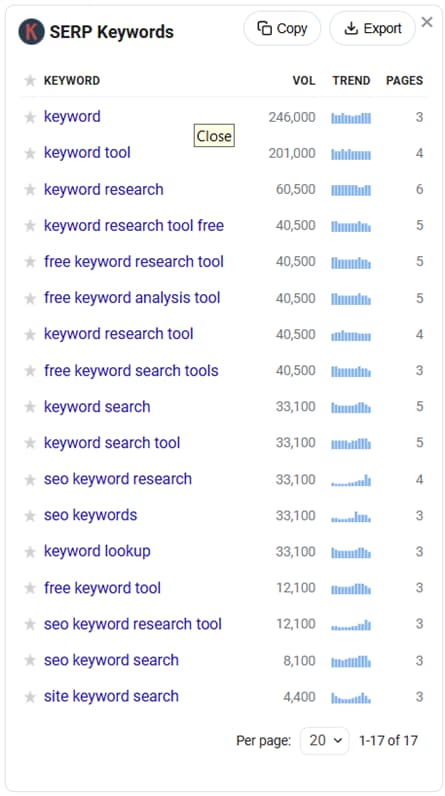
4. Competitive Keyword Research
With Keywords Everywhere, you can do competitor keyword research even without switching tabs. Just key in the search term on Google and get data straight from the SERP.
Keywords Everywhere subscription comes with a Moz bar too, helping you readily check each competing page’s domain authority, backlink profile, and organic traffic. To easily do competitor analysis, just click the part highlighted below, and you’ll instantly see all other search terms that page is also ranking for– keywords you can also incorporate as you develop your content.
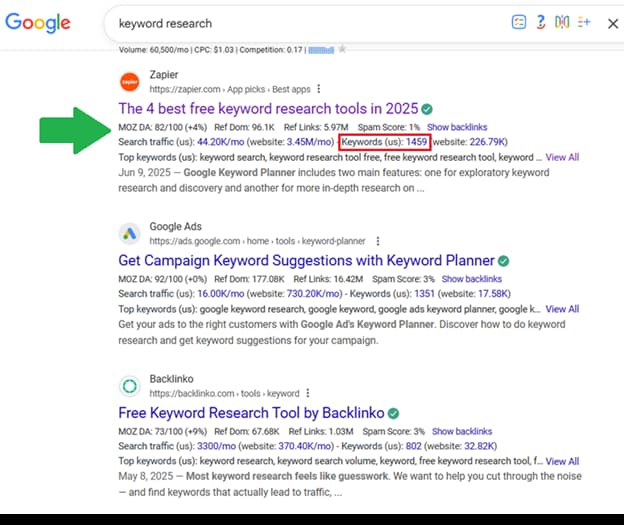
There are many other ways to do competitor research with Keywords Everywhere. To get the full picture, read our full guide on How to Find Competitor Keywords.
5. Advanced Add-on Features
Keywords Everywhere users also get access to more add-ons that can supercharge the overall SEO workflow– from on-page tweaks to technical SEO. Here’s how each tool can help you work smarter, not harder:
- SEO Minion– Automate various SEO tasks like On-Page SEO analysis, Hreflang tag checking, Broken link checking, SERP Preview, PAA Downloading and more. A lot of SEO activities can be very tedious and repetitive, and SEO Minion acts as your literal ‘minion’, automating repetitive tasks so you focus on strategy instead of busywork.
- SEO Checker– Another add-on offering that helps you optimize for SEO, speed, and security. It automatically detects SEO issues, warnings, and areas for improvement. If you’re struggling to pinpoint what’s holding your site back, SEO Checker can highlight exactly what needs fixing and guide you on actionable improvements.
- Keyword Planner– Keywords Everywhere users can also access our browser extension Keyword Planner that helps generate more long-tail keywords and organize them according to variations– long-tail, question-based, comparison-based, and preposition-based keywords. If you are looking to hone in on niche searches, this browser add-on can be super handy.
How to Generate Keywords Effectively
Generating keywords is not just about pooling a bunch of high-volume search terms. It ultimately requires thinking strategically and carefully validating your ideas. Content marketing done right can be expensive, so you need to really nail the fundamentals to drive ROI and get the best results. Here’s what that looks like in practice:
1. Expand Keyword Ideas Thoroughly
Even without using a keyword research tool, it’s fairly easy to presume what search terms people are likely to use to find your website. For example, if you’re selling clothes and fashion items, it’s easy to imagine people typing in terms like shirt, pants, skirt, blouses.
However, because of how broad these search terms are, it’s highly unlikely for you to compete and rank for such queries. Your best bet is to target long-tail or specific keywords that have lower Keyword Difficulty but higher search intent.
In this fashion niche example, it’s also easy to think up more specific search terms you can validate. You can add modifiers to your main categories or core terms like: yellow shirt, denim pants, floral skirt, casual blouses. You can generate this main list of keywords you think would best describe your products and services and use a keyword generator to validate and expand your ideas.
Using Keywords Everywhere, you can validate and expand any keyword idea straight off the bat via the autosuggest section:
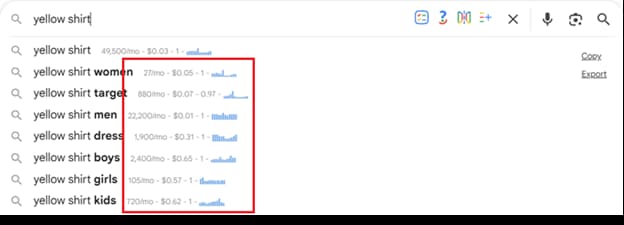
If you look at the Long-tail Keywords widget, you can explore more ideas and modifiers people are actually using as queries. You can hit the star icons to mark keywords as favorites or use the Copy and Export functions to store them for future sorting and analysis.
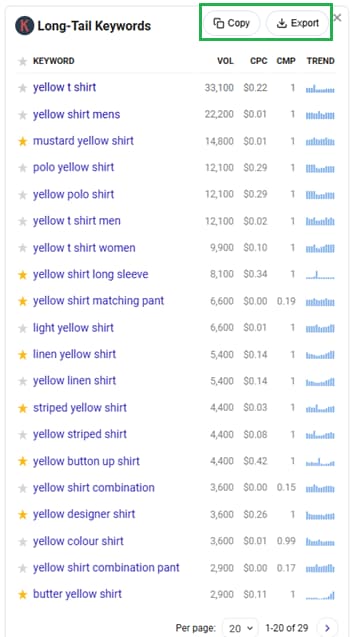
You can further narrow down your keyword research by adding prepositions like ‘with’’, ‘for’’, ‘and’’, etc.
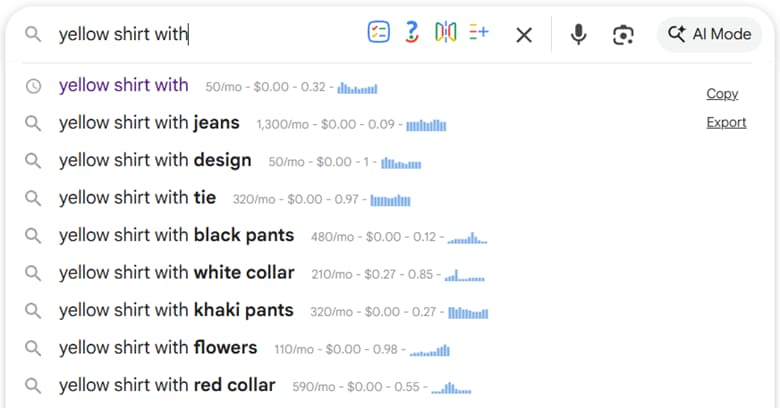
Using a keyword generator like Keywords Everywhere, you’d be able to (1) validate your keyword ideas and only pick ones with actual search demand and (2) discover more relevant and specific keywords you haven’t thought of before. Once you gather your more relevant keywords, get ready to organize them for better targeting, which leads us to the next point.
2. Group keywords
Using the fashion niche example above, a good idea is to create categories based on your most prominent products and services. For example, if you have lots of yellow tops in your inventory, you can always just rely on your product page’s filtering setting for users to easily navigate their options. However, from a search engine perspective, filtered results are often not indexed or optimized.
A good idea is to create categories and subcategories according to features, materials, intended use, and target audience. Does that mean you have to create a dedicated page for yellow tops? The best answer is it depends on what product categorization approach works best for your niche and target audience. Look at all the high-demand keywords you can target and create a page hierarchy that won’t overcomplicate your site’s navigation. This may involve combining or condensing categories and grouping keywords according to relevance.
The point of grouping keywords is to avoid cannabilization. Instead of creating multiple pages for each yellow-related query, you can group them in the form of a category page, a product page, or even a blog round-up post. Grouping keywords works really well, whether you’re targeting transactional, commercial, or informational queries.
For example, for informational topics, the following keywords are just different variations of the same search intent or pain point:
- clothes to make you look slimmer female- 880
- how to look slimmer with clothes- 2,400
- clothes that make you look thinner- 1,600
- outfits to look slimmer- 1,300
- what clothes to wear to make you look slimmer- 390
- how to dress thin- 210
- slimming clothes for big tummy- 320
- slimming clothes- 1,000
The values above correspond to their monthly search volume. Each keyword above represents the same search query, expressed in different ways. Instead of targeting each of the keywords above separately, just group all similar keywords and cover them in one comprehensive article to increase the total search volume, improve the chances of discoverability, and avoid keyword cannibalization.
3. Prioritize keywords
After grouping keywords, you can start targeting them by creating their corresponding pages. However, depending on your budget and resources, you may not be able to cover multiple pages all at once. You can start with the most important ones and eventually expand your subcategories or support pages depending on relevance and demand.
For informational pages, grouped keywords can also be a great way to supercharge organic traffic. Just strive to target long-tail keywords and check Keyword Difficulty and Rankability before targeting informational search terms.
For example, you may want to cover a blog article targeting summer outfit ideas, with a total search volume of 8,100. However, if you’re just a newer website, you’d be competing against high-DA sites and would have to work harder to rank for such search terms. You can boost your chances of making it to the first page by targeting easier keywords like the following:
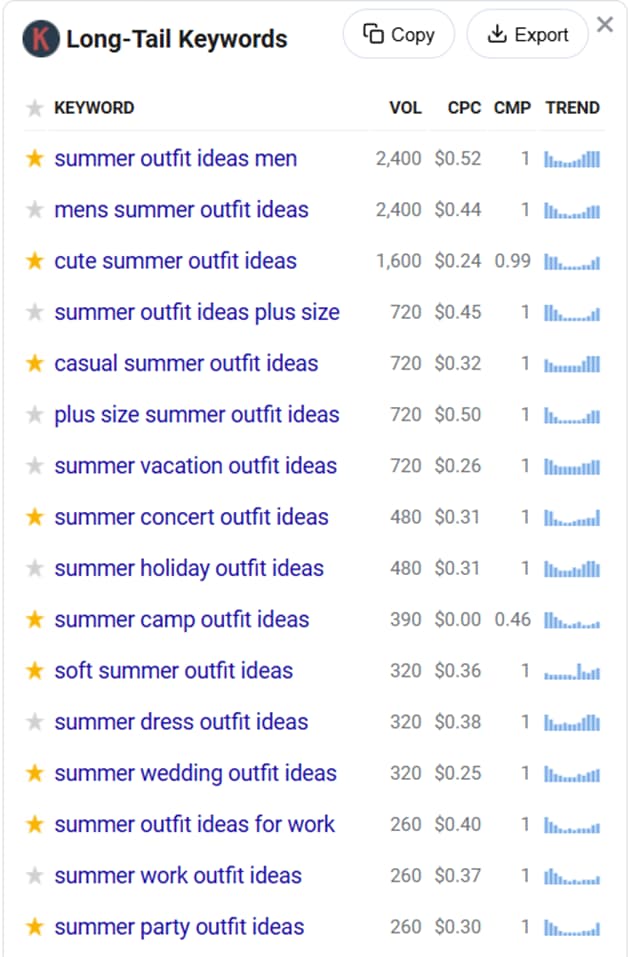
Besides checking the DA, you can instantly verify how hard it is to rank for such keywords using Keywords Everywhere’s SEO Report widget.
Just type the query you want to examine in Google’s search box and click “Check Rankability for SERP” under Run SEO Report, and then choose the LLM you want to use to power the report, whether ChatGPT, Claude, Gemini, or Deepseek.
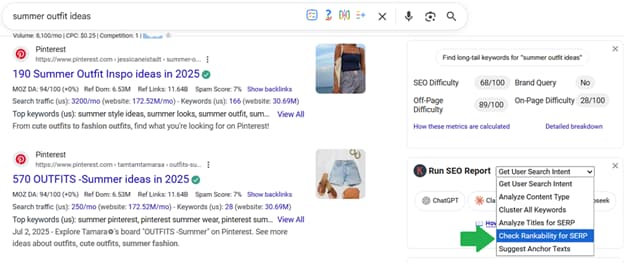
In a few seconds, AI will run a report showing the difficulty metrics of the search term.
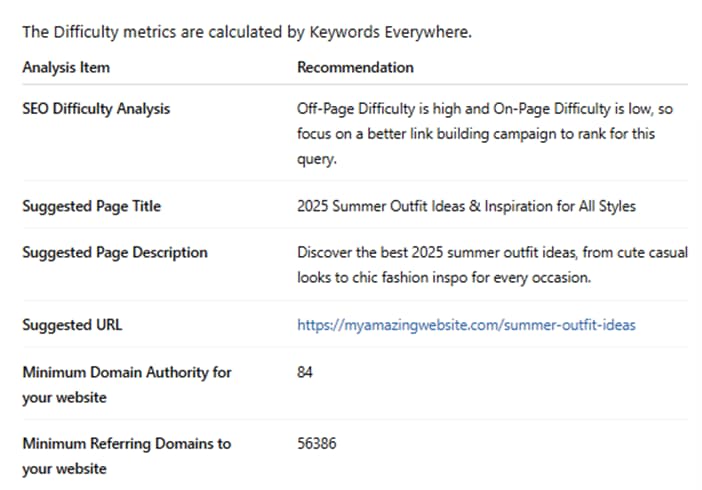
Check the ‘Minimum Domain Authority’’ requirement, and it gives you a good gauge of how easy or hard it is to rank for such a target query.
As you can see above, the Minimum Domain Authority is 84. If you’re a newer website, that’s a rather tough benchmark.
On the other hand, if you try going for a long-tail keyword like ‘soft summer outfit ideas’ as suggested by the Keywords Everywhere long-tail keywords widget. The DA requirement for rankability is much lower, which helps you to rank and attract organic traffic faster and easier.

The long-tail keyword ‘soft summer outfit ideas’ only has a monthly search volume of 320 as compared to the broader query ‘summer outfit ideas’ with 8,100. However, if you strategically target multiple long-tail keywords, that would eventually amount to faster traction and, eventually, more discoverability.
4. Target Keywords with Business Potential
There are a lot of lucrative keywords you can target to get found by the right audience. If you’re looking to add value and make headway through content marketing, make sure every keyword you target will ultimately point towards conversion.
For example, in the fashion niche, you should only be targeting keywords around the types of clothing and products you offer and the things potential customers need to know before they make a purchase. It doesn’t quite make sense to target any other keyword that is not a part of the buying journey. For instance, you no longer need to cover keywords that are too far off the purchasing process like:
- how to wash denim jeans
- how to care for viscose fabric
- history of streetwear
To drive qualified traffic and ROI, be strategic about your keyword targeting and focus on all the search terms that would lead to desire and conversion.
Final Thoughts
Continue stimulating new ideas and uncovering popular search terms using a keyword generator. Be consistent and focus on adding value in your every attempt to gain reach and visibility.
The goal is to make your content the best resource for the query. Google won’t bother ranking your content if it doesn’t provide better value than its competitors. Keyword research is only half the work. The rest lies on how effectively and compellingly you engage your audience to the point of trust, interest, and ultimately, conversion.


